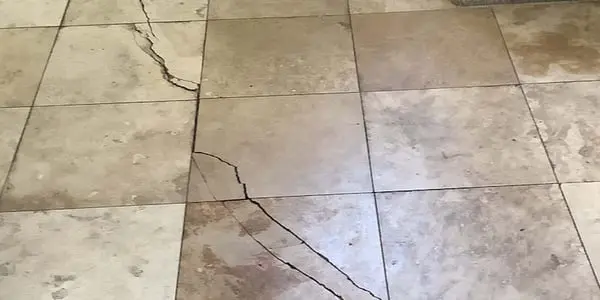We get it. You’re on a mission to determine the origin of your cracked bathroom, kitchen, or laundry room tile. You want to know what, exactly, is causing your lovely tile to fracture? This is a great question because there are numerous possible causes, from poor tile installation to dropped ACME safes. The unfortunate truth is – tile cracks are always a symptom, not the underlying issue. And some underlying issues are more serious than others.
Don’t worry, we got you covered. Dalinghaus Construction Inc. has over 100 years of combined foundation repair experience. We’ve seen our fair share of cracked tile, caused by a multitude of factors. We are here to walk you through the various causes of your cracked tile. This article will cover 3 relatively benign sources of cracked tile and 2 more serious origins.
So, let’s dive in.

3 Benign Causes of Cracked Tile
Many homeowners, probably not unlike yourself, are concerned that tile cracks are indicative of a serious, expensive, and structurally compromising issue. Not every tile fracture is cause for sleepless nights. Below is a brief outline of 3 benign cracks that do not pose a serious threat to the structural integrity of your home (but are still nevertheless a nuisance).
Poor Installation Causes Cracked Tiles
Proper tile installation is everything, ensuring the tiles are flat, even, and secure. Poor tile installation can quickly fracture cracks through your kitchen, bathroom, and laundry room. One of the biggest examples of improper tile installation is not utilizing enough adhesive across the entirety of the tile (which results in an uneven position) This creates voids beneath the tile, which weakens the structural integrity of the porcelain and ceramic.
In addition to not using enough adhesive, sometimes the wrong kind of mud or glue is utilized. For example, mud/adhesive mixtures that allow for no flexibility once they dry are too stiff. It’s important to have a marginal amount of play to avoid fractured tiles.
Heavy Impact Causes Cracked Tiles
If you drop a heavy enough object on your tiled floor, odds are the tile will fracture. The tile is more likely to crack if there were installation problems to begin with – such as not enough adhesive and the wrong kind of adhesive. So, if you stumble upon a new crack, there’s a good chance your children or partner may have dropped a hefty item onto the tile.
Heavy Loads Cause Cracked Tiles
Heavy loads, such as hefty household appliances (refrigerators, washing machines, dryers, etc.), can fracture your tile due to intense, sustained stress. This generally only happens when weak, poor tile quality is used. It’s imperative to install the right type of tile for the right location/job. For example, wall tiles used on the laundry room floors are not strong enough to sustain your dryer.
Two Serious Causes of Cracked Tile
Foundation Settlement and Foundation Heave Cause Cracked Tile
When we discuss foundation settlement and foundation heave, we are really discussing two sides to the same coin: expansive soil. Expansive soils, such as clays and loam soils, expand and contract in direct correlation with the water table. In short, more water expands the volume of the soil, and less water shrinks the volume of the soil.
This seasonal shrinkage and expansion exert a tremendous amount of pressure on your foundation. This can cause your foundation to sink, which we refer to as foundation settlement. Or it can cause your foundation to distend. This pressure travels through your foundation and up into the framing of your home, cracking tile along the way.
This is considered a more serious issue because simply replacing busted tiles won’t help. The root cause must be addressed, or you will be replacing tile into eternity. You will want to address the issue ASAP because if you do not, your home will continue to deteriorate.
The best way to address foundation settlement is through push pier and helical pier underpinning. To learn more about underpinning, read our article What is Underpinning (Definition, History, & Types).
Book An Inspection for Peace of Mind
In this article, you learned about 3 relatively benign sources of tile cracks: poor installation, impact, and inordinately heavy loads. You also learned about foundation heave and settlement, more serious issues that can crack tile and compromise your home’s structural integrity.
Dalinghaus Construction Inc. has serviced thousands of foundations. We would be happy to inspect your tile cracks to determine if your home is suffering from foundation settlement or foundation heave.
If you live in Southern California or Arizona and would like to book a free foundation inspection, click the link below.






